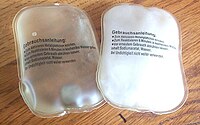
Photo from wikipedia
Abstract We investigated the microstructures and their formation mechanisms of carbonate salt based composite phase change materials (CPCMs). Such materials typically consist of a carbonate salt as the phase change… Click to show full abstract
Abstract We investigated the microstructures and their formation mechanisms of carbonate salt based composite phase change materials (CPCMs). Such materials typically consist of a carbonate salt as the phase change material (PCM), a thermal conductivity enhancement material (TCEM) and a ceramic skeleton material (CSM) for structure stabilisation, and are mainly for medium and high temperature thermal energy storage applications. Two carbonate salt based composites were studied with one being eutectic NaLiCO3 and the other Na2CO3. MgO and graphite flakes were used respectively as the CSM and TCEM for fabricating the composite modules. A scanning electron microscope with energy dispersive spectrometer (SEM-EDS) was used to observe the microstructures and the salt distribution and redistribution within the composite structures during repeated melting-solidification cycles. The results showed salt migration within the composite structure during the thermal cycling. Such a microscopic motion led to a more homogenous distribution of not only the salt but also the CSM and TCEM. At a low graphite flake loading, breakage of the graphite flake was observed, suggesting stress generation during thermal cycling. The extent of the breakage reduced with increasing graphite flake loading, suggesting the stress generation be related to microscopic motion. The MgO based CSM particles were likely to be sintered, forming a porous structure. Such a structure reduced the swelling effect partially due to the use of graphite on which the salts had a poor wettability.
Journal Title: Solar Energy Materials and Solar Cells
Year Published: 2019
Link to full text (if available)
Share on Social Media: Sign Up to like & get
recommendations!